Antique Apples: A Guide for Eaters and Growers
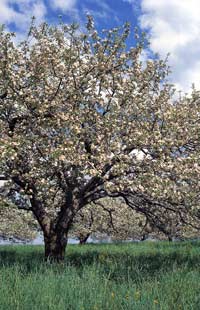
Most antique or heirloom apples are distant cousins to the commercial varieties available on supermarket shelves today. While modern varieties such as 'Red Delicious' have been selected for their consistent appearance, cosmetic appeal, and tolerance of long shipping and repeated handling, antique varieties were often selected for their cider-making quality ('Golden Russet'), their retention of flavor and firmness without refrigeration ('Winesap' and 'Baldwin'), or their intense and unusual flavor—without regard to external appearance. Until modern growing, storing, and transportation technologies revolutionized apple cultivation in the 1920s, farmers preferred late-ripening, hard apples that remained edible after many months in a cool cellar, were relatively tolerant of pests, and grew vigorously in pasture orchards without fertilizers or weed control. For example, 'Macoun' and 'Northern Spy' are well suited to cool-climate regions of the Northeast and can tolerate the cold winters of that region. Today's home fruit growers may appreciate these same traits—but they must be prepared for apples that can be rather rough in appearance, require a few months in the cellar to mellow and attain their characteristic flavors, and produce a crop only every few years (a good pest-avoidance strategy for the tree). They also have to contend with trees that are extremely vigorous and quickly outgrow their limited space in the backyard, unless they are grown on one of several dwarfing rootstocks available today. But home growers will be rewarded for all their troubles with a tasty crop that offers varied and unusual fruit flavors and textures, excellent cider making or cooking attributes, and a unique eating experience. 'Roxbury Russet', for example, provides an unusual tart, nutty flavor and makes excellent pie and cider too. 'Keepsake' remains wonderfully crisp and juicy for many months and has a delicate anise flavor that belies its rustic exterior.
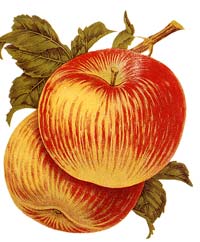
Seeking out antique apples can become real detective work. Varieties often have a slew of synonyms or local names—'Lady Apple', for example, has also been called at various times and places 'Lady's Finger,' 'Petit Api', 'Pomme d'Api', 'Pomme Rose', 'Christmas Apple', 'Lady Sweet', and dozens of other names. 'Fameuse' is also called 'Snow Apple', 'Snow Chimney', 'Chimney Apple', 'Red American', 'Royal Snow', and 'Chimney Point'. Synonyms for 'Baldwin' include 'Butter Apple', 'Woodpecker' or 'Pecker', 'Flech', and 'Steel's Red Winter'. Growers either assigned these various names in good faith to what they thought were newly discovered apples, or enterprising farmers and nursery operators concocted the names as part of their marketing strategies. Whatever the motives behind the array of names antique apples accrued, the resulting confusion has made it difficult to say with certainty which apple is which.
Pomologists in North America and Europe have gathered and preserved samples of almost 5,000 presumably different varieties of apples by placing seeds and/or vegetative cuttings in major germplasm repositories in Geneva, New York; Angers, France; Villaviciosa, Spain; and East Malling, England. (Detailed descriptions and information about the national apple collection in Geneva is available online at www.ars-grin.gov/gen/applesmain.html.) The definitive scientific identification and genetic characterization of each variety in these collections were until recently somewhat suspect, but they have become considerably more precise thanks to new technologies such as DNA fingerprinting. This technique has already revealed some duplications that have resulted from apple varieties with multiple names. Even so, there is really no way to know what proportion of the truly unique apple varieties, or genotypes, are included in the world's apple germplasm collections and conserved for posterity, and how many have been lost forever.
Save Antique Apples by Growing Them
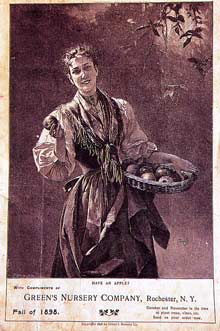
The best way to ensure the survival of antique apples is to grow them in small plantings in diverse conditions around the world. These plantings provide insurance against possible disease introductions or weather events that could strike the large germplasm collections described above. Home and small-scale commercial orchardists are the ideal agents to carry out this mission. Many home orchardists have become interested in old varieties, both for personal enjoyment and as a way to help conserve the apple's genetic heritage. No matter where you live, you are likely to find from a few to dozens of antique apples suited to your region. An excellent source of information for gardeners interested in growing antique varieties is the Fruit, Berry and Nut Inventory, by Kent Whealy and Joanne Thuente. It is one of several compilations of antique fruit and vegetable varieties supported by the Seed Savers Exchange, in Decorah, Iowa. It includes a comprehensive listing and brief descriptions of the climate zones and pest susceptibility for the 1,513 apple varieties currently available as grafted trees from commercial nurseries in North America. It has similar information about many other fruit and nut crops. Several nurseries around the United States and Canada now specialize in young trees of antique apple varieties.
Save Them by Eating Them
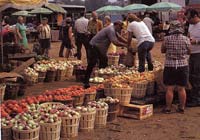
If you don't have the space, time, or desire to grow antique apples in your garden, you can still enjoy their distinctive flavors and tree-ripened succulence. You are likely to find a few local varieties at nearby farmers' markets or at pick-your-own orchards in your area, and many small-scale farmers around the country now specialize in antique varieties. A good place to start searching for orchards near you is the Orchard Trail, which can be found on the Apple Journal website (http://www.applejournal.com/trail.htm). This site lists orchards and their contact information throughout the United States, Canada, and several other countries. If your area lacks orchards or farmers' markets, you can still sample these fruits by ordering antique apples online from growers around the country. Keep in mind that the shipping costs can be substantial and that ripened fruit may suffer during transit.
Save Them by Finding Them
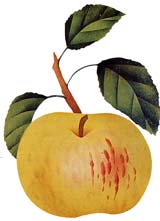
Trees of antique varieties sometimes survive, lost and neglected, in old fields and forests, abandoned homesteads, and even suburban backyards. For this reason devotees are always on the lookout for old apple trees with unusual fruits. It is not easy to identify a tree that hasn't been pruned or protected from pests. To determine a tree's identity, apple experts use a number of methods. Among them are a close examination of some basic attributes:
- healthy fruit, including lengthwise and crosswise sections, patterns of stripes and russeting (brownish roughened patches of skin), red or orange blush and underlying green, white, or yellow skin color of ripe fruit
- bark patterns
- presence or absence of fuzziness (pubescence) on leaves and young stems
- the typical vigor of the tree
In some regions, local commercial growers or curators at botanical gardens and germplasm repositories may be able to identify varieties. Local pick-your-own orchards that specialize in antique apples are another good place to get information. You can browse their plantings for apples similar to your own, or take in a few samples of clean, sound fruit to see if they can be identified. If there are master gardeners or cooperative extension agents in your county, they may know of local horticulturists who can identify antique or unusual apple varieties.
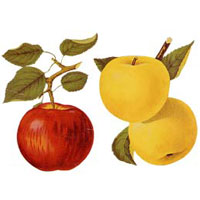
RIGHT: 'Grimes Golden' originated in West Virginia in 1804, near a cider mill and farm established by John Chapman, better known as Johnny Appleseed. [Illustration: Tim Hensley Collection]
In any case, well-formed edible apples that are free of "worms" and rots are essential for identification purposes. Sampling a few young twigs and healthy leaves can also be helpful, as bark and leaf characteristics are useful traits for identification. Even when you can't positively identify a rare or antique apple tree, by grafting a few buds of a tasty variety onto another tree or a rootstock, you can still grow and enjoy it as your own special mystery apple.
Another wonderful resource for serious antique apple research is The Apples of New York, published by S.A. Beach in 1905, which is out of print but available at university and other specialized libraries. The two-volume set contains extensive descriptions and illustrations of apples cultivated in the eastern United States during the late 1800s—an era when thousands of small farms included orchards of local varieties that are no longer grown commercially. As yet there is no illustrated Web-based apple-identification key; a tool like this would greatly facilitate the characterization and conservation of antique apples.


